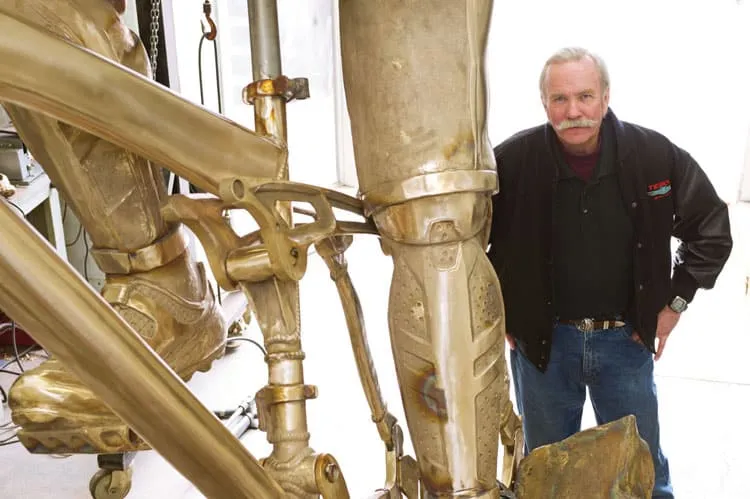Lundeen displays a knack for business
2013 Bravo! Entrepreneur

Sharing a workspace with a 12-foot bronze athlete or a bench with President Lincoln might be inspiring or intimidating, but for brothers Mark and George Lundeen of Lundeen Sculpture, it’s part of everyday life.
The Lundeens are internationally renowned sculptors who have helped Loveland become a hallmark destination for sculptors. George’s wife, Cammie Lundeen, is a sculptor, as is George and Mark’s sister-in-law, Bets Holland Lundeen. Their brother, Nelse, does the number-crunching for the family business, which has taken over nearly a block of Loveland’s East Fourth Street. Various children, grandchildren and cousins work for the eight-person outfit.
“Anytime you can get your friends or family to help you, support you or give you a push, it helps everything – your ego, your finances, everything,” George said.
SPONSORED CONTENT
The Lundeen brothers’ work is displayed in stadiums, corporations, universities and public spaces throughout the country.
They are perhaps best known for George’s rendition of pioneer aviator Elrey B. Jeppesen, on display in the Jeppesen Terminal at Denver International Airport, and Mark’s “Astronaut: Portrait of Jack Swigert,” which can be viewed in Statuary Hall in Washington, D.C.
The Lundeen brothers grew up in Holdrege, Neb. Their father was an insurance agent, but he was also an inventor and supported his kids’ creative inclinations.
In the 1970s, George moved to Loveland from Nebraska after discovering Art Castings of Colorado, which was and still is, one of the premier bronze-casting foundries in the world. Although George had degrees and experience supporting his experience as an artist — he was a Fulbright-Hayes Scholar for fine art and had taught ceramics and art appreciation at the University of Nebraska, Carnegie — the foundry didn’t need an artist, it needed a floor sweep.
But George understood the intrinsic value of working as a cog of one of the world’s greatest bronze-casting foundries and took the job.
“When you’re put in a place like the foundry, it’s like a big wheel,” George said. “At the center is the foundry. Then there’s the artists. It doesn’t mean we were very successful, but it allowed us to deal with art galleries and we got to know them because we worked with them pretty much every day.”
When gallery representatives visited the foundry, George made sure his work was on display. A year and a half later, he got a call from a Chicago gallery asking for 20 pieces for an opening.
“I told them I had 17 pieces or 18 pieces, but actually I didn’t have any,” George said. “I had six months to get ready. I worked day and night and had 25 for the big show.”
After the show, he opened a studio in Loveland and started selling work throughout the West.
“I think there’s a lot of truth to the idea that in business, it’s not what you know, but who you know,” George said.
Mark joined George in Loveland after a post-college trip around Europe left him anxious, interested and ready for something different.
“He didn’t want to stay in middle Nebraska,” George said. “He worked for me for about a year-and-a-half and then started sculpting. Right away he was very successful.”
Mark opened a studio down the street from George and started selling his own work in 1983.
“I started working with George and really enjoyed what I was doing,” Mark said. “I figured if George could do it, I could do it.”
Lundeen Sculptures produces about six new sculptures annually, depending on commission size, and participates in three to four shows. At any given time, the Lundeens’ work can be seen in 18 to 20 galleries around the country.
While remarkable Loveland foundries such as Art Castings of Colorado and Bronze Service of Colorado attracted sculptors to Loveland, the strong sculpting community and the successes reaped by that community have turned Loveland into a haven for artists.
Today, Loveland has the largest outdoor sculpture event in the country — the Loveland Sculpture Invitational — and is the annual meeting ground for the National Sculptor Society.
The Lundeens, it’s fair to say, had a lot to do with helping Loveland establish its reputation and profile as an arts town.
“It’s fun to see how Loveland has transpired from a sleepy retirement town to a city known for its sculpture,” George says.
To further support Loveland’s sculpting community, the Lundeens and a few other local artists started the Artists’ Charitable Fund 20 years ago as a way to help artists during medical hardships.
“A lot of artists don’t have insurance,” George said. “This helps them get through – helps them with the rent, clothes for their kids, stuff like that.”
Sharing a workspace with a 12-foot bronze athlete or a bench with President Lincoln might be inspiring or intimidating, but for brothers Mark and George Lundeen of Lundeen Sculpture, it’s part of everyday life.
The Lundeens are internationally renowned sculptors who have helped Loveland become a hallmark destination for sculptors. George’s wife, Cammie Lundeen, is a sculptor, as is George and Mark’s sister-in-law, Bets Holland Lundeen. Their brother, Nelse, does the number-crunching for the family business, which has taken over nearly a block of Loveland’s East Fourth Street. Various children, grandchildren and cousins work for the eight-person outfit.
“Anytime you can get…
